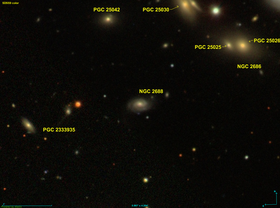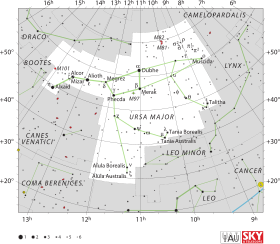NGC 2688
| NGC 2688 | |
 La galaxie spirale NGC 2688. | |
| Données d’observation (Époque J2000.0) | |
|---|---|
| Constellation | Grande Ourse |
| Ascension droite (α) | 08h 55m 11,6s[1] |
| Déclinaison (δ) | 49° 07′ 21″ [1] |
| Magnitude apparente (V) | 15,8[2] 16,8 dans la Bande B[2] |
| Brillance de surface | 12,75 mag/am2[2] |
| Dimensions apparentes (V) | 0,3′ × 0,2′[2] |
| Décalage vers le rouge | 0,052035 ± 0,000085[1] |
| Angle de position | 96°[2] |
Localisation dans la constellation : Grande Ourse | |
| Astrométrie | |
| Vitesse radiale | 15 600 ± 2 km/s [1] |
| Distance | 232,52 ± 16,28 Mpc (∼758 millions d'al)[1] |
| Caractéristiques physiques | |
| Type d'objet | Galaxie spirale |
| Type de galaxie | Sb[1] S0[2],[3] |
| Dimensions | environ 47,17 kpc (∼154 000 al)[1],[a] |
| Découverte | |
| Découvreur(s) | R.J. Mitchell[3] |
| Date | [3] |
| Désignation(s) | PGC 25048 MCG 8-16-40 NPM1G +49.0113[2] |
| Liste des galaxies spirales | |
| modifier |
|
NGC 2688 est une vaste et lointaine galaxie spirale située dans la constellation de la Grande Ourse. Sa vitesse par rapport au fond diffus cosmologique est de 15 765 ± 12 km/s, ce qui correspond à une distance de Hubble de 233 ± 16 Mpc (∼760 millions d'al)[1]. NGC 2688 a été découverte par l'astronome irlandais R. J. Mitchell en 1858.
Wolfgang Steinicke et le professeur Seligman classent cette galaxie comme une galaxie lenticulaire, mais la photo prise par l'étude SDSS montre clairement la présence de bras spiraux. Aussi la classification Sb indiquée sur la base de données NASA/IPAC semble plus juste.
Notes et références
[modifier | modifier le code]Notes
[modifier | modifier le code]Références
[modifier | modifier le code]- (en) « Results for object NGC 2688 », NASA/IPAC Extragalactic Database (consulté le )
- « Les données de «Revised NGC and IC Catalog by Wolfgang Steinicke», NGC 2600 à 2699 », sur astrovalleyfield.ca (consulté le )
- (en) Courtney Seligman, « Celestial Atlas Table of Contents, NGC 2688 » (consulté le ).
Voir aussi
[modifier | modifier le code]Articles connexes
[modifier | modifier le code]Liens externes
[modifier | modifier le code]- (en) NGC 2688 sur la base de données NASA/IPAC Extragalactic Database
- (en) NGC 2688 sur la base de données Simbad du Centre de données astronomiques de Strasbourg.
- (en) NGC 2688 sur la base de données LEDA
- NGC 2688 sur le site de SEDS
- (en) NGC 2688 sur WikiSky: DSS2, SDSS, GALEX, IRAS, Hydrogène α, Rayon-X, Photo, Sky Map, Articles et images
- (en) NGC 2688 sur le site du professeur C. Seligman
Text is available under the CC BY-SA 4.0 license; additional terms may apply.
Images, videos and audio are available under their respective licenses.

